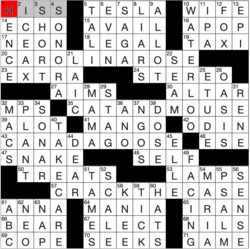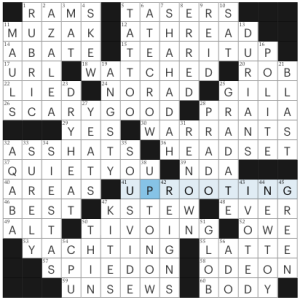Note: No WSJ puzzle today due to the Christmas holiday.
Kurt Weller’s New York Times puzzle – Sophia’s write-up
Happy holidays folks! It’s gonna be a short write up today since I’ve got back to get back to being around my family :)
Theme answers:
- 20a [Stick your tongue out, say] – MAKE A FACE
- 34a [Move onto a new topic of conversation, metaphorically] – SWTICH GEARS
- 43a [Pass to a different owner, as a business] – CHANGE HANDS
- 59a [Epitome of precision … or a description of 20-, 34- and 43-Across?] – CLOCKWORK
So each of the idioms relate to things that make a CLOCK WORK. Do the first words of the theme answers matter? I guess that the hands of a clock make the FACE, and they CHANGE with the them, and the GEARS move…. but maybe it’s simpler than that and I’m just supposed to think about the last word. Either way, it’s a pretty tight theme, which is nice.
There’s some really nice fill in today’s puzzle! ROCK OPERA and ANTITOXIN are both great, and I would have liked MNEMONIC if I knew how to spell it (I also didn’t know the mnemonic mentioned in the clue, [Memory device like “How I wish I could calculate pi,” e.g.]). There’s also some things that were less great, like URIS, COE, ELY, PEN IN, and maybe even GREER and ESSEX. I might have liked to see slightly cleaner fill even at the expense of a long answer or two or some of the rarer letters like X or Z.
Lynn K. Watson and Will Nediger’s Los Angeles Times crossword — Stella’s write-up

Los Angeles times 12/26/22 by Lynn K. Watson and Will Nediger
This is a theme that, had its revealer been the title of the puzzle, would have been right at home in USA Today; with a revealer, it goes here in LAT on Monday. Said revealer at 57A [Solve a mystery, and a hint to the answers to the starred clues] is CRACK THE CASE. That is, each theme entry “cracks” the word CASE with a bunch of letters inserted somewhere into CASE:
- 20A [*Pink flower native to eastern North America] is a CAROLINA ROSE.
- 35A [*Like a game that involves evasive subterfuge] is CAT-AND-MOUSE.
- 43A [*Migratory honker] is CANADA GOOSE.
I tend to find this type of theme most interesting when the split word is split differently in each theme entry (C/ASE, CA/SE, CAS/E), but this way, in which the word is split consistently CA/SE in all three theme answers, works too.
I could do without TALI and LAIC on Monday, but otherwise the grid is very smooth, leading to a sub-two solve.
Will Nediger’s New Yorker crossword—Amy’s recap
Tough one today, eh?
Fave fill: TEAR IT UP, SCARY GOOD (this describes the top solvers at the Boswords Fall Themeless League, where Will Nediger finished second in the standings with blazing fast speed), ASSHATS, YACHTING. a DRY HEAT from the Southwest, SHAHADAH (also spelled shahada, this pillar of Islam is the profession of faith), DURIANS, SOUS-VIDE, I VOTED.
Less keen on a Twitterian A THREAD, UNSEWS (!), UPROOTING crossing UP TO NOW at UP’s P.
Did not know:
- 9d. [Haida sculptor Bill], REID. A noted artist of the Haida Nation, in Canada.
- 20a. [Environmental activist Hopkins who co-founded the Transition Network], ROB. He’s British.
Fun clue: [Word confused with a name, in an “Airplane!” gag], SURELY. “Surely you can’t be serious.” “I am serious. And don’t call me Shirley.”
3.5 stars from me.
Jimmy Peniston’s Universal crossword, “Twist Your Words” — pannonica’s write-up

Universal • 12/26/22 • Mon • Peniston • “Twist Your Words” • solution • 20221226
No write-up as yet. This is a post-facto post, as I was unable to do crosswords for a few days. I’ll try to drop in some more discussion (still) later on.
·p·


I would like the NYT better if not for the gratuitous mention of a wristwatch in the clue for 11d. At first I thought that had something to do with the theme. Maybe it should have, or STRAP could have been clued some other way.
Sophia, the way I read it all the answers describe WORK that is done on a CLOCK. Repair work or creation, either way, would involve MAKING A FACE, CHANGING HANDS, and SWITCHING GEARS.
Agree. STRIP @ 11D and TRIBE @ 12D for VIBE @ 22A would have avoided the problem, or STROP/TRITE/VOTE.
Or cluing STRAP with reference to a purse, or a carseat, or….
Am I correct that there’s no WSJ puzzle because there’s print edition of the newspaper today?
I just assumed there wasn’t a puzzle because of the holiday. And there isn’t one on their website. But if there’s a print edition, what puzzle is in it? (I don’t have a subscription.)
Sorry, I meant “there’s no print edition.”
TNY … Yikes! Aside from not being able to open the .puz file I got using Crossword Scraper with the online interface I usually use and being forced to solve it with the now unfamiliar AcrossLite interface, I had absolutely zero chance of completing this puzzle. I was surprised to see Will Nediger’s name in the byline afterward since I’ve had a relatively easy time with his previous 9 TNY puzzles.
I spent a long time trying to figure out what an ATH READ might be. Oops!
That made me laugh, Mr. [] Grumpy
I didn’t know DURIANS, and went with tURIANS. Seemed like a long series of tweets might be A THREAt (at least to one’s sanity).
I’m still trying. Is A THREAD short for something like “a’hole’s thread”? Seriously, it means nothing to me.
But then so did a heck of a lot in this puzzle, where I was writing things meaningless to me after goodness knows how long to fill at least a dozen empty crossings. Hated it.
DURIAN did, eventually, ring a bell, but then it crosses this ROB guy and PRAIA near REID, TEAR IT UP, SHAHADAH, a weapon that for all I knew (what with “light” in the film title) might as well have been “laser,” and so much else. It was, though, ASSHATS, AQABA, and the Airplane joke that left me with enduring blanks. And not dead sure why SW weather is a projection. From Freudian weather forecasts?
I encounter A THREAD on twitter when someone is retweeting a series of tweets (a thread) they find particularly interesting.
Thanks much. Googling for A THREAD wasn’t helpful at all, not surprising given that the word “thread” is hardly short of usages, perhaps most often these days as an online discussion although also in context of a revival of design and craft as something harder to dismiss as “women’s work.” But in any case, no specifics about this Twitter usage. Anyhow, I do use Twitter, but that didn’t help me either.
Should we think, then, of the usage the puzzler had in mind? I think rather that it’s just an awfully forced attempt at an “I’m young and aware and you’re not” clue.
Yikes indeed.
I breezed through the NW and SE corners, got a little slowed down by the SW, and punted on the NE. Everything makes sense now that I see it (kicking myself for not figuring out GILL; I had the two L’s and could only think of Jethro Tull, whose “Aqualung” album once graced my LP collection.
Actually, the capital of Cape Verde doesn’t sound at all familiar.
So here’s my favorite song by a wonderful Cape Verdean singer:
https://www.youtube.com/watch?v=dNVrdYGiULM
You win this one, Will Nediger.
I don’t know why the NYT says that X-shaped railroad crossing signs are old-fashioned. That’s still a standard sign, called the R15-1 or crossbuck in the Federal Highway Administration’s Manual on Uniform Traffic Control Devices. It’s required at all roadway-railroad grade crossings, except for certain light-rail crossings.
Just thought you’d like to know.
Two theories:
(1) The crossbuck was one of the first traffic signs to be widely used. (Just guessing here.)
(2) The constructor and editors are fortunate to live somewhere where grade crossings of railroad tracks have been eliminated, so they haven’t seen a crossbuck in years. (I’m not so fortunate; there are several grade crossings within a few miles of my house. And some of those freight trains are really long.)
Crossbucks are “Yield” signs. At least in populated areas, a gate is the preferred configuration. In my area, I have seen many crossbucks replaced with gates preceded by “Advance Warning Signs” (yellow circular signs with cross-bars), so the clue seemed fine.
Eric is right that the crossbuck design is quite old (and it does look old-fashioned). I discovered a history of this sign at https://www.roadtrafficsigns.com/railroad-crossing-crossbuck-sign-history. (What can’t you find on the Internet?) It was used at least as early as 1926. It appeared in the first edition of the MUTCD, in 1935, although at that time the arms of the crossbuck weren’t at right angles.
Martin, as I read the current MUTCD, flashing-light signals and automatic gates (which must also include flashing-light signals) are still required to display the crossbuck. The Grade Crossing Advance Warning (W10-1) sign is used, in addition, in advance of the crossing. (BTW, R in a sign name means regulatory (usually black on white), and W means warning (usually black on yellow). There are also several other classes of signs.) These are national standards, but states can modify them to a certain extent, and no one is in charge of enforcing them. So I don’t doubt what you say.
TMI? You never know down what rabbit hole a seemingly innocuous crossword entry might lead. FYI, I’m not a traffic engineer, but I do use information like this in my bicycle advocacy work, so I’m familiar with the technical sources.
Thanks, Alan.
I’m a little surprised that the MUTCD only goes back to 1935. I’d have guessed it came out in the 1920’s.
Your intuition is correct, Eric. Several standards for traffic signs, signals, and markings were published in the 1920s by highway officials for rural areas and by a safety-oriented group for urban areas, but they weren’t always complete or consistent with each other. The need for coordination and uniformity led to a joint committee that produced the first MUTCD. You can find a brief history at https://mutcd.kittelson.com/history/mutcd-development/. (The crossbuck came from the safety group. The highway officials preferred a circular sign.)
Thanks again.
I’m out of town for the holidays but when I’m back I’ll check those crossings that I thought were just a gate with flashing red lights now.